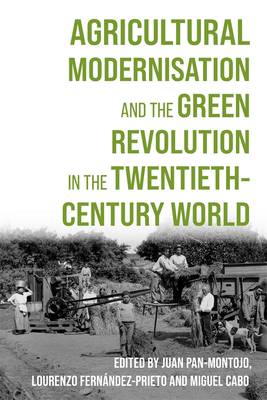
- Afhalen na 1 uur in een winkel met voorraad
- Gratis thuislevering in België vanaf € 30
- Ruim aanbod met 7 miljoen producten
- Afhalen na 1 uur in een winkel met voorraad
- Gratis thuislevering in België vanaf € 30
- Ruim aanbod met 7 miljoen producten
Zoeken
Agricultural Modernisation and the Green Revolution in the Twentieth-Century World
€ 209,45
+ 418 punten
Omschrijving
An overarching history of the origins, development, and application of agricultural innovation in the past, and of the paradigms and institutional frameworks in which they were developed throughout the twentieth century. From the late nineteenth century onwards, rural societies and agrarian production across the world were profoundly transformed. Prior to the Second World War, technological innovations developed within an intensive organic framework and advanced largely in dialogue with existing producers. After the war, social engineering became the prevailing model in agricultural and rural policies almost everywhere. Modernisation was imposed from above, targeting so-called "archaic" or "anti-modern" peasants and farmers, who were pushed to produce ever-greater quantities of food, timber, and other raw materials through the expanded use of industrial and inorganic resources. Applied as a USA political programme in Asian, Latin American and African countries, this strategy became known as the "Green Revolution". Although it undermined rural societies and eroded the sustainability of agricultural production, it remained central to political agendas, leaving a difficult legacy for future generations. This book analyses agrarian change and agricultural policies before and after 1945, highlighting the socio-economic and environmental consequences of these two very different periods in global agrarian history. Its diverse case studies span continents and political systems, considering topics from post-war reconstruction in the UK and Denmark to development policies in the Belgian Congo and post-fascist Ethiopia; from production projects in communist Hungary to agricultural transformations across the Southern Cone and India. Chapter 6 is available as Open Access under the Creative Commons licence CC BY-NC-ND
Specificaties
Betrokkenen
- Uitgeverij:
Inhoud
- Aantal bladzijden:
- 320
- Taal:
- Engels
- Reeks:
- Reeksnummer:
- nr. 9
Eigenschappen
- Productcode (EAN):
- 9781837653317
- Verschijningsdatum:
- 3/03/2026
- Uitvoering:
- Hardcover
- Formaat:
- Genaaid
- Afmetingen:
- 156 mm x 234 mm

Alleen bij Standaard Boekhandel
+ 418 punten op je klantenkaart van Standaard Boekhandel
Beoordelingen
We publiceren alleen reviews die voldoen aan de voorwaarden voor reviews. Bekijk onze voorwaarden voor reviews.







